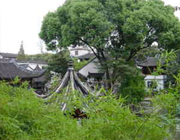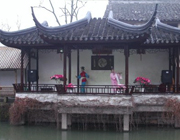Lion Grove Garden
Lion Grove Garden (Shizilin) is located on 23 Yuanlin Road, in the northeast of Suzhou-a city with profound cultural background and convenient developmental advantages. Lion Grove Garden is one of the four most famous and representative gardens of ancient classical style in Suzhou City.
Built in 1342 during the Yuan Dynasty (1279-1368) by Monk Tianru and a grou p of Zen Buddhist disciples as a memorial of their master-Monk Zhongfeng, Lion Grove Garden has changed hands and renamed a number of times. Its changeable history is because Monk Zhongfeng had once apperceived the Buddhism sutras at Lion Cliff on Mountain Xitianmu in Zhejiang Province. Also there was many rocks grotesque in shapes in the garden resembling lions. It was first given the name Lion Grove, this name was changed to Bodhi Orthodox Temple (Puti Zhengzong) in 1342. Lion Grove Garden had been a popular center of literatis and Buddhism activities. Many paintings and poems were inspired by the garden at this time.
p of Zen Buddhist disciples as a memorial of their master-Monk Zhongfeng, Lion Grove Garden has changed hands and renamed a number of times. Its changeable history is because Monk Zhongfeng had once apperceived the Buddhism sutras at Lion Cliff on Mountain Xitianmu in Zhejiang Province. Also there was many rocks grotesque in shapes in the garden resembling lions. It was first given the name Lion Grove, this name was changed to Bodhi Orthodox Temple (Puti Zhengzong) in 1342. Lion Grove Garden had been a popular center of literatis and Buddhism activities. Many paintings and poems were inspired by the garden at this time.
Covering an area of about 10,000 square meters (two and a half acres), Lion Grove Garden is an ideal sightseeing site as it has richly ornamental pavilions and towers in different styles; each has its own history and story. True Delight Pavilion (Zhenquting) is said to be the most magnificent in Lion Grove Garden due to its royal style and Emperor Qianlong of the Qing Dynasty, who visited the gardens six times, in 1765, wrote its plaque. The name of Standing-in-Snow Hall (Lixuetang) came from a Buddhist story about a pure-hearted Zen adherent standing in snow for a whole night to worship his master. Pavilion for Greeting the Plum Blossoms (Wenmeige) was a place where painters and poets indited. In addition to the plum treesaround the pavilion, all the furnitures and  utensils inside are decorated or carved with beautiful plum blossom designs. Furthermore, many rare tablets and steles, paintings and calligraphies are kept in Lion Grove Garden , including precious artwork "Panoramic View of" by Ni Yunlin, also called Ni Zan, and the "Twelve Scenic Spots in Lion Grove Garden" by Xu Ben, both were famous painters from the Ming Dynasty.
utensils inside are decorated or carved with beautiful plum blossom designs. Furthermore, many rare tablets and steles, paintings and calligraphies are kept in Lion Grove Garden , including precious artwork "Panoramic View of" by Ni Yunlin, also called Ni Zan, and the "Twelve Scenic Spots in Lion Grove Garden" by Xu Ben, both were famous painters from the Ming Dynasty.
The whole structure of Lion Grove Garden shows a flavor of Zen Buddhism and is an apotheosis of the gardens constructions. A part of the Imperial Summer Resort of the Qing Dynasty in Chengde of Hebei Province was a mimic of Lion Grove Garden. The garden occupies a very important place in history, representing the diversity of cultural and architectural development in Suzhou over the years.